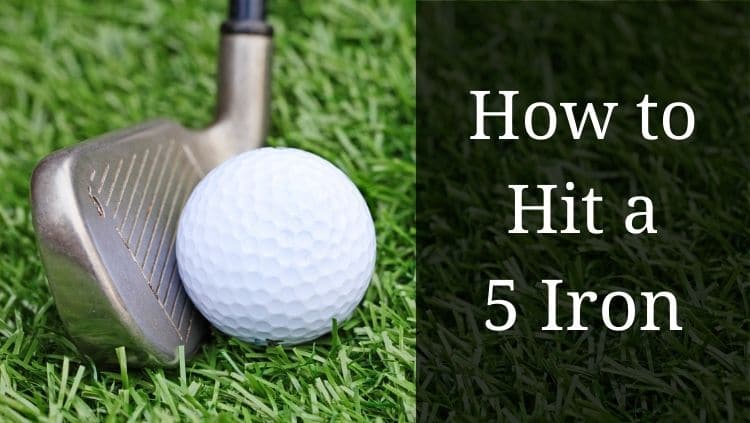When it comes to hitting a 5-iron, most amateur golfers find themselves struggling to find the confidence.
Whether it is an issue of ball position or flaws in the golf swing, a 5-iron can trouble amateurs.
So, with this article, we look to demystify this mid-iron, providing a road map for you to find your groove with the 5-iron and achieve better contact.
If you are looking for more consistency and distance, you have come to the right place, as we’ll take apart the fundamentals of hitting pure 5-iron shots.
At the end of our step-by-step approach to hitting better long irons, you will find consistent contact and become comfortable hitting the other long irons beyond the 5-iron.
How to Hit a 5 Iron
Types of 5-Iron Shots
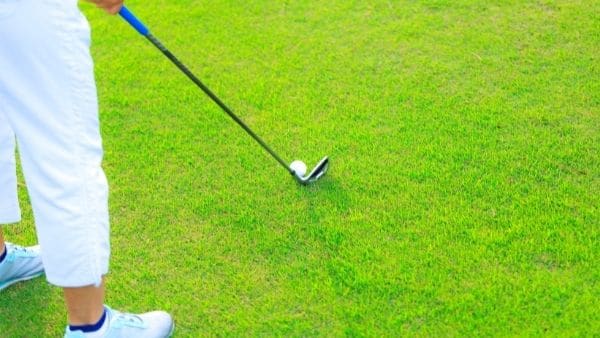
Full Swings
When I use the term “full swing,” I’m referring to hitting the golf ball with maximum swing speed.
Regardless of whether you are hitting a punch shot or approach shot with the 5-iron, a full swing means you are executing a full hip rotation with a solid front leg that allows you to hit the ball with a good flight path.
Understanding the role of the club face in relation to its loft and launch angle is crucial, as it affects your swing and ball flight.
Punch Shots
Punch shots have become a dependable weapon for many PGA Tour golfers with a low, piercing ball flight and trajectory that demands the golfer move the ball slightly back in their stance to create the low shot shape with maximum ball speed.
The most significant difference between a punch shot and full swing comes from the plane of attack and follow-through.
While a full swing takes a steep path with a high finish around the head, a punch shot needs a more rounded swing with a finish around the ribcage.
Chip Shots
I know what you are thinking, and yes, many golfers like to use their 5-iron to hit chip shots around the green.
Here’s the reason why; the low loft of the 5-iron keeps the ball low and rolling quickly in the same way that a putter does on the green.
Using the leading edge of the clubface and with a ball position closer to the back foot, golfers can cleanly hit the ball to bypass the light rough or extended green in front of them to nestle the ball closer to the pin to save par.
Inexperienced golfers should practice hitting these chip shots early in their golfing journey to prevent thin shots that skip across the green.
Yardage with 5-Iron
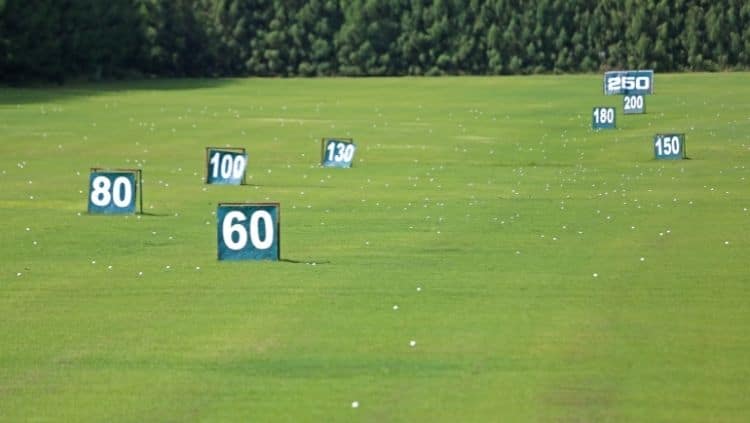
With the 5-iron, as with any long iron in your golf bag, always remember that swing speed translates to yardage.
While amateur golfers may not swing as hard with their short irons as they hit long irons, they must reach a minimal distance to achieve results to shoot lower scores.
When you start training on extending your 5-iron length, consider how wrist positioning can affect the effective club length.
The following yardages will give you enough distance to meet your overall goals of finding more consistency and distance control.
Professional Golfer
With elite club speed, professional golfers exceed 200 yards routinely with their longer irons, and in this case, the 5-iron.
Tour pros routinely reach more than 220 yards when they hit a 5-iron, making it a dynamic weapon in their golf bag when they swing a club from this distance with enough speed.
Hitting long irons for professional golfers remains similar to when the average golfer hits their mid-range irons.
While the shot’s accuracy can be affected by wind and other exterior influences, the golf ball lands softly on the green with moderate spin and spin rate.
Intermediate Golfer
While the pro golfer hits their 5-iron slightly longer than the advanced amateur, these impressive golfers routinely make solid contact when hitting long irons, delivering exceptional club speed to the ball.
This group of players hits their golf balls with their 5-iron anywhere from 180 to 200 yards on average, often achieving a consistent shot shape.
Amateur Golfer
Your average weekend warrior, most amateur golfers, someone who plays once a month with a mid-range club speed, will hit the ball with their 5-iron about 160-170 yards of carry distance.
One of the biggest obstacles to overcome for this player when lowering their scores is extending distance with all clubs, including their short irons.
By playing a short iron from 160 yards instead of the mid-iron club, golfers will impart more spin on the ball to provide more distance control with their ball striking.
Before the Swing
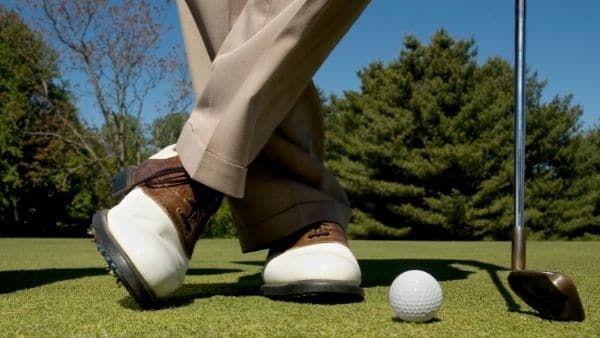
When I’m asked how to hit a 5-iron with more authority during a lesson, I always tell my students to show me their stance.
Nine times out of ten, if they are struggling with this club, it has to do with what they establish before ever swinging the long iron, particularly their address position.
Hitting long irons takes patience and skill.
Some instructors will tell you that you should hit your 5-iron like you do your 8-iron, and while that may sound easy, achieving good contact and hitting long irons with more consistency is a bit more complicated.
Feet
Let’s start with your feet.
Yes, you want distance with your 5-iron, so the natural inclination from some amateurs is to spread their feet wide, increasing their stance width like when they hit a driver or a fairway wood on the golf course.
But in my experience, while that might add a few yards on a drive, that can really throw off the timing when you try to hit long irons.
So, keep your feet at shoulder width and make sure your toes on both feet are even at address. Too many swing problems come from the lousy alignment that begins with the feet.
If you are unsure of your positioning, take an alignment stick, a great golf accessory, and point it toward your target line on the driving range, working on making your toes touch evenly on that imaginary line.
Ball Position for 5-Iron
You want the ball to be slightly forward of center at address with a long iron, often achieved with a slight forward press. With the lower loft, the ball’s forward helps increase ball flight for maximum carry.
With most of my students, I encourage them to play the ball directly in the center of their stance with wedges.
Using that spot as a starting point, move the ball roughly three ball-lengths forward from center, toward your lead foot, for the ideal placement on a full club swing with your 5-iron.
If you find that this positioning causes you not to hit the ball solid regularly, feel free to adjust to find that perfect spot for consistency.
Pro Tip
One of the easiest ways to make sure that you are clearing your hips through the golf ball is by flaring your lead foot, which means the left foot for most golfers, out at a 30-40 degree angle.
Now, this tip does not mean that you are offsetting the foot or dropping it back because you don’t want to open up your stance.
The best way to ensure that you are staying aligned is by taking an alignment stick and pointing it directly toward your target line to ensure that you are evenly distributing your feet.
By cheating your lead foot, you give your hips a better chance at clearing and making sure your clubface returns to square.
Backswing
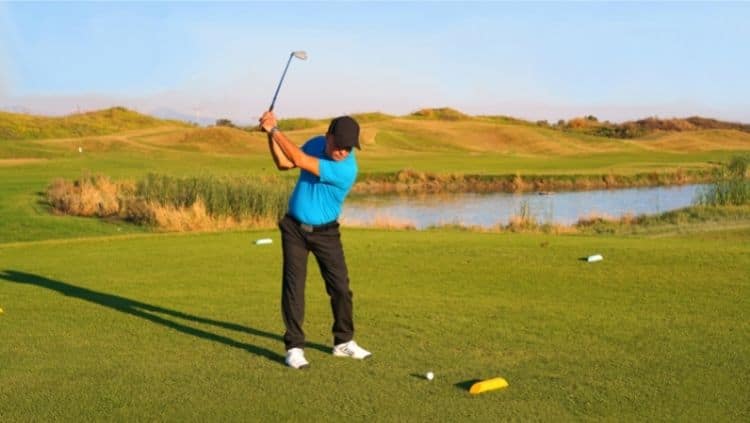
If you were to take a picture of the ideal backswing at its conclusion, you would have the longest iron, typically the 5 iron, pointed directly down the target line at the green.
But how do we get to that point when we hit long irons?
Well, we’ve already worked ourselves into a fundamentally sound position at address. So, the next step is beginning the backswing with the iron, ensuring it stays on the correct swing plane.
Arms & Hands
Remember, the takeaway is a coordinated movement that utilizes the hands, arms, legs, back, and hips. So we are starting with the arms and hands in unison, taking the iron back to get it on plane.
The arms and hands are immediate sensors in the golf swing. They provide the response and feel that let us know if the swing works when we hit long irons.
On the takeaway, the arms and hands begin, then trigger the shoulders and hips, incorporating a proper wrist hinge to keep the 5-iron along the plane that goes back and through the impact point.
Full Shoulder & Hip Turn
As you begin to move the 5-iron back, your shoulder will rotate around the center of your body, creating a coil. The same rule holds true of your hips.
At the top of the backswing, your lead shoulder should be under your chin, and your hip will have moved roughly 30 degrees to the inside.
A great way to see this movement is by recording yourself or having a coach monitor the movement.
All amateurs need to see themselves on video to understand better how they hit golf shots, especially their process when they hit long irons.
Pro Tip
Dialing in a consistent backswing with your long irons does take considerable patience in the beginning.
While most drills can be tedious to execute, I use one of my favorite drills to keep my students engaged.
Take two balls, placing one in the normal address position, and the second roughly four inches behind the first ball.
The drill is simple.
You’ll move the iron back as you normally would in the takeaway, but you want to focus on hitting the rear-positioned ball with the back of the 5-iron and rolling the ball directly along the target line.
If you roll the ball to the right or left of the imaginary line, then you hit it off-track and your takeaway is already offline.
Work on keeping the ball rolling directly behind you to help groove your takeaway.
Check our tips on how to do a backswing correctly.
Downswing
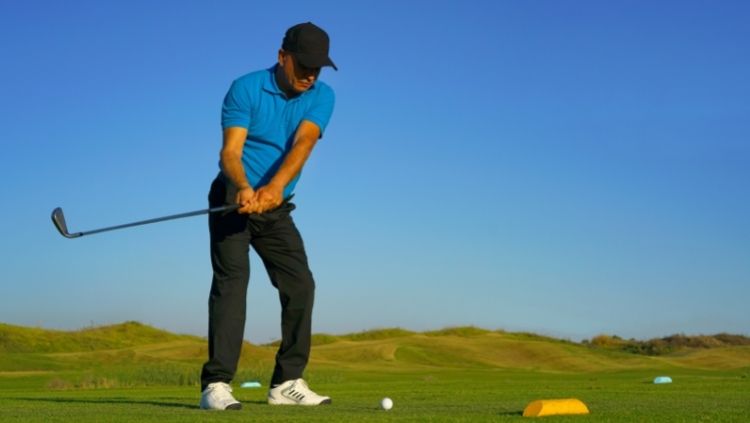
Now, you are momentarily holding the club at the top of the backswing, and the time has come where you need to trigger the release and downswing with the 5-iron.
Lowering the clubface back to the ball in a square position demands a synchronized movement of several things. The hips must open, creating the slot the club follows to hit the shot cleanly.
The weight held on the back leg must move toward the front foot, without the hips sliding, to keep the momentum moving through the ball.
In the end, the body goes from its coiled position to an uncoiling juggernaut that delivers power to the ball.
And don’t forget, after impact, the clubface should extend along the target line to a clean follow-through with the club behind the upper body, from the neck to the top of the head.
That list of objectives may seem like a tall order, but once you hit long irons a few hundred times during practice and course play, you quickly understand what’s necessary to create shotmaking with these dynamic clubs.
Pro Tip
The Shoulder-to-Shoulder is a simple long iron drill that I love using with my golf students.
While the name might provide a hint of what the golf drill entails, I want my golfers to first understand what it feels like to hit 100-yard shots with their long irons.
By gaining experience with how it feels hitting the shorter lengths, they can begin building their consistency the same way when they hit long irons.
I firmly believe that amateur golfers need to practice small to build confidence in their golf swing execution when the shot calls for maximum club distance.
So, on this drill, you just need your 5-iron. Taking a more compact stance, you want the takeaway of the club to go no further than shoulder-high.
The same rule applies to the follow-through as I want the golfer to finish around the height of the lead shoulder.
The drill calls to hit shots with these restrictions until the golfer routinely dials in 100 yards with ease while also gaining confidence in the quality of their contact.
After hitting a couple of dozen shots, then you can extend the golf swing, increasing in power using your regular stance.
If the drill works correctly, you should feel more centered when hitting the long irons in your golf bag.
Frequently Asked Questions
How should you hit a 5 iron?
To hit a 5 iron effectively, focus on a smooth, controlled swing with proper ball contact.
Position the ball slightly forward of center in your stance, and ensure your weight shifts to your front foot during the downswing.
Use a relaxed grip and avoid overswinging. Aim to sweep the ball off the turf, allowing the loft of the club to do the work. Practice consistency in tempo and alignment for better results.
Where should a 5 iron be in your stance?
Position the 5 iron slightly forward of center in your stance. For most golfers, this means placing the ball under your left armpit (for right-handed players).
This position promotes a descending strike, helping you compress the ball for optimal distance and trajectory.
Avoid placing the ball too far back, which can cause thin or topped shots, or too far forward, leading to inconsistent contact.
Why can’t I hit my 5 iron?
Struggling with a 5 iron often stems from poor ball contact or swing mechanics. Common issues include trying to scoop the ball, an inconsistent setup, or inadequate swing speed.
Focus on proper ball positioning, a downward strike, and maintaining good posture throughout the swing.
If the issue persists, consider professional lessons to refine your technique or verify if your 5 iron’s shaft flex and length suit your swing.
Why does my 5 iron only go as far as my 7 iron?
This is typically due to swing inefficiencies or insufficient swing speed to take advantage of the 5 iron’s lower loft.
Poor ball contact or inconsistent strikes can also negate the distance advantage of longer irons. Work on improving your swing mechanics, including a proper downward strike and centered contact.
If swing speed is the issue, consider switching to hybrid clubs, which are easier to launch and deliver better results for slower swing speeds.
